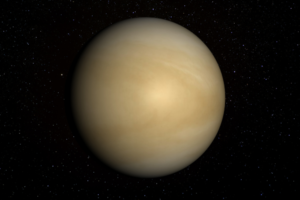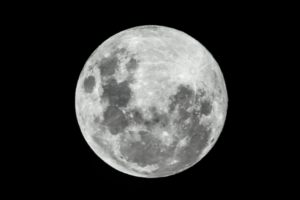What Is A Red Dot Finder On A Telescope? How To Use It?
Disclosure: This post contains affiliate links and I may earn a small commission (at no extra cost to you) if you click through and make a purchase. Thanks in advance – I really appreciate it!
Many of my friends who are new to the field of astronomy ask me a lot of general open-ended questions about the telescopes and most of them want to know – “What exactly is a red dot finder and do I need one?”
Key Takeaways:
What is a red dot finder on a telescope?
A red dot finder is a zero magnification optical device that uses a small ground glass screen to superimpose the image of a small red dot or a circular reticle onto the sky. To use the Finder, look through the sight tube and move the telescope until the red dot/reticle merges with the object.
In this article, I will explain in detail how to use a red dot finder on a telescope, types of red dot finders, how they differ from finderscopes and I will also suggest the best red dot finders that you can buy online today.
What is a Red Dot Finder?
When my friends ask me this question, in very simple terms I tell them that – Red Dot Finders are used to carry out a first, approximate, alignment on an object in the sky so that when viewing through the telescope, even with a low power eyepiece the chosen object will appear in the field of view.
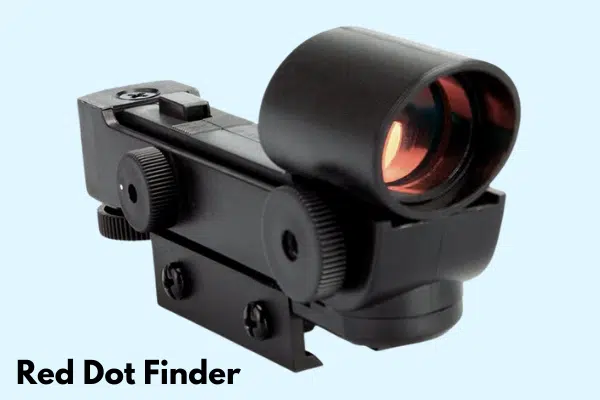
Using a telescope might seem as simple as pointing it towards the sky and looking through it, but it’s actually a bit difficult than that.
Trying to locate objects directly through a telescope eyepiece can be quite difficult so it is normal to have a sighting aid i.e the red dot finder installed on the telescope tube and aligned with the main optics.
Since the Red dot finder generally has a wider field-of-view as compared to the main telescope, the Finder makes it easier to navigate the sky.
How Does a Red Dot Finder Work?
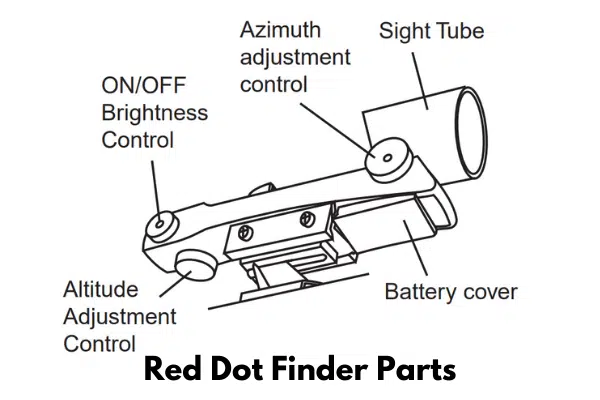
The Red dot finders nowadays are supplied with the majority of small telescopes. It consists of a small ground glass screen onto which is projected a red dot or a circular reticle from a red LED that shows a fixed angular diameter projected onto the sky.
The image of the projected red dot or reticle is nearly free of parallax, which means the reticle appears in a fixed position against the distant sky no matter where you place your eye behind the finder.
The Red Dot Finder is powered by a 3-volt lithium battery located underneath at the front.
The brightness of the dot/reticle can be adjusted to suit the viewing conditions. The brightness control usually acts as the on/off switch as well.
How To Align the Red Dot Finder
To help you find your way around the sky, you have to first properly align the Red dot finder with your main telescope.
Here’s how you can easily do that:
- Take the telescope outside during the day.
- Find a street sign, telephone pole, a church spire, or something further away.
- Insert a low-power eyepiece in your telescope’s focuser.
- Look through your main telescope and locate that far away object and position the telescope so that the object is in the center of the field of view.
- Mount your Red dot finder onto your main telescope.
- Use the adjustments on the Red dot finder to make the red dot/reticle overlap the far-away object.
- If the red dot overlaps the object, your Red Dot Finder is perfectly aligned with your telescope.
- If not, turn its azimuth and altitude adjustment controls until the red dot/reticle is merged with the object.
Here’s a video to help you understand more about Red Dot Finders and how to align them with your telescope.
Best Red Dot Finders For a Telescope
Compared to the naked eye, a telescope shows a very narrow field of view. That makes it a little difficult to aim and find a specific sky object.
A zero magnification, wider field-of-view Red dot finder is one of the most beneficial telescope accessories for any telescope. Even when using computerized telescopes, a Red dot finder can still be very useful.
Here are my top 4 recommendations for the best Red dot finders that you can buy.
1. Telrad Finder Sight
- The easiest way to aim a telescope. The view seen through the window of the Telrad is continuous with the sky around it, not magnified or upside down.
Prices pulled from the Amazon Product Advertising API on:
Product prices and availability are accurate as of the date/time indicated and are subject to change. Any price and availability information displayed on [relevant Amazon Site(s), as applicable] at the time of purchase will apply to the purchase of this product.
The Telrad Finder Sight provides a non-magnified window on the sky and projects 1/2 inch, 2-inch, and 4-inch illuminated red bullseye circles on the screen which can be brightened or dimmed for user needs.
Simply place the star in the center of the bullseye and start star hopping. Both beginners and seasoned veterans alike will surely enjoy Telrad’s red circle view because it makes it easy to compare to star charts and find objects.
2. Celestron StarPointer Finderscope
- The Star Pointer Finderscope adds “point and look” functionality to any telescope!
- This red dot finder keeps the sky right-side up, matching what you see with your unaided eyes
- The adjustable red dot is bright enough to see day or night
- Attaches to just about any telescope thanks to the small footprint, even works great with astronomical binoculars and spotting scopes
Prices pulled from the Amazon Product Advertising API on:
Product prices and availability are accurate as of the date/time indicated and are subject to change. Any price and availability information displayed on [relevant Amazon Site(s), as applicable] at the time of purchase will apply to the purchase of this product.
With the Celestron StarPointer Finderscope, aiming is as easy as aligning the red dot on the target area. The non-magnified LED screen provides a clear window to the stars and the adjustable brightness red dot provides a visual reference to where the telescope is pointed – day or night.
The Celestron Red Dot StarPointer reflex site makes a great accessory to all telescopes, including birdwatching and binoculars. Simply attach the included mount with screws or double-sided tape and you’re ready to go!
3. Celestron StarPointer Pro Finderscope
- Designed by astronomers for astronomers, this premium finderscope allows you to precisely zero in on your target
- Projects a dual-circle reticle, not a red dot that can obscure your subject
- Larger 40 mm optical window offers a wider field of view so you can acquire targets quickly and easily
Prices pulled from the Amazon Product Advertising API on:
Product prices and availability are accurate as of the date/time indicated and are subject to change. Any price and availability information displayed on [relevant Amazon Site(s), as applicable] at the time of purchase will apply to the purchase of this product.
The Celestron StarPointer Pro Finderscope is designed to cut down on time spent finding the target, and increase time spent gazing upon the beauty of the heavens you’ve been searching for.
Compared to traditional red dot finderscopes that obstruct your desired target with a red LED light, the StarPointer Pro uses circular reticles that avoid blocking your target; instead of lining up the dot, you capture it within the circle- at which point it’s ready to be observed through the eyepiece.
4. Rigel Systems QuikFinder
- One Tenth the size & weight of some other reflex sights, makes aiming your telescope easy with its wide-open right-side-up view.
- Projects 1/2 and 2 Degree Red circles Onto the Night Sky in focus with the stars.. what you see in the red circles is what you get in your telescope
- Compact Design Lets You Use Both Eyes to see fainter than with other reflex sights.
Prices pulled from the Amazon Product Advertising API on:
Product prices and availability are accurate as of the date/time indicated and are subject to change. Any price and availability information displayed on [relevant Amazon Site(s), as applicable] at the time of purchase will apply to the purchase of this product.
The Rigel QuikFinder is perfect for binoculars & small and large telescopes. It Makes Starhopping easy with its Pulsed Reticle.
The compact QuikFinder has a black body of rugged construction, tough ABS Plastic, and comes standard with 2 quick-release bases for use on more than one telescope.
The Rigel QuikFinder attaches without drilling and is easily removed from its baseplate for storage. The finder’s display projects a variable brightness Red LED image that is dotted with a 2 degree and a 1-degree circle on the lens element.
A built-in Dew Cap comes standard. The unit is powered by a 3-Volt lithium battery
5. SVBONY Red Dot Finder
- This red dot sight comes with an adjustable small red LED dot is projected onto a non-magnifying viewing window so you can aim the main telescope quickly and easily
- Thumbwheels allow positioning of the red dot horizontally and vertically for precise telescope alignment
Prices pulled from the Amazon Product Advertising API on:
Product prices and availability are accurate as of the date/time indicated and are subject to change. Any price and availability information displayed on [relevant Amazon Site(s), as applicable] at the time of purchase will apply to the purchase of this product.
SVBONY Red Dot Finder is the way to go if you are looking for a pocket-friendly and easy way to locate the object and center it in your eyepiece. An adjustable small red LED dot is projected onto a non-magnifying viewing window so you can aim the main telescope quickly and easily.
It can attach to just about any telescope due to its small footprint, it even works great with astronomical binoculars and spotting scopes.
Types of Red Dot Finders
Most stargazers use one of the two variants of Red dot finders. In contrast to the red dot types, these ‘project’ concentric circles onto the sky and are, perhaps, easier to use.
- Telrad Finder
- Rigel Quikfinder
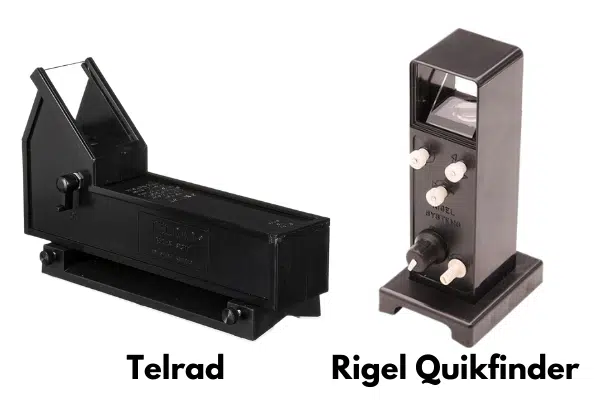
Telrad Red Dot Finder
The Telrad was developed in the early 1970s and it’s now perhaps the best known and most widely used reflex finder. Many star charts and planetarium apps incorporate Telrad reticles to aid in star hopping to faint objects.
The Telrad includes a base that mounts on a telescope using a strip of secure adhesive tape, so it’s not necessary to drill holes in the telescope tube to mount the device. The Telrad can be easily removed from its base when you want to store the device.
A Telrad is about 8.25″ long and accommodates the optical path of the light from the LED and collimating optics and two AA batteries to power the LED.
Rigel Quikfinder
The Rigel Systems QuikFinder presents a more compact alternative to the Telrad. With a length of just 2.5″, this unit-power reflex finder has a much smaller footprint than a Telrad and weighs only 3 oz, so it can mount on essentially any telescope.
It’s about 4.5″ tall which makes it easy to sight without straining your neck. As with the Telrad, three adjustable screws aid in the alignment of the optical axis of the Telrad with your telescope.
Red Dot Finders vs Finderscopes: What’s the difference?
The main difference between a Red dot finder and a finderscope is that Red dot finders have zero magnification whereas the latter have some magnification power.
Also, it’s not necessary that all finderscopes will have illuminated reticles which use a red LED, whereas all Red dot finders do have LED-powered red dot/reticles.
A Red Dot Finder or reflex finder is not much different from a gunsight, made up of a crosshair or a dot inside a circle.
Once this target finder scope is aligned with your telescope, you’ll be able to observe objects through your telescope’s eyepiece by simply placing the intersection point of the crosshairs or central dot as close to the center of the object as you can.
A red dot finder is preferred by many amateur astronomers because the illuminated reticle, crosshairs, or simple red dot is easily seen in the dark and can be made brighter or dimmer whenever necessary.
The pointer, powered by a red LED, appears superimposed on the night sky as we view through the finder.
Finder scopes are smaller optical devices that you usually see mounted on the side of larger telescopes. Typically, the scope attaches to the telescope’s optical tube so that it’s automatically pointed in the same direction.
Finderscopes generally come with larger and more expensive scopes and are essentially small refractors.
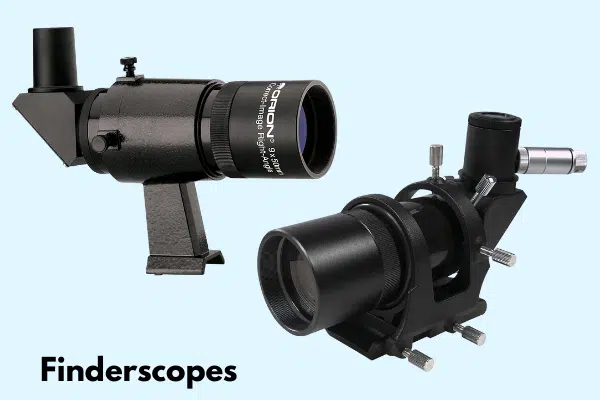
It uses a series of lenses to magnify the image. The difference, however, is that finder scopes have low-powered magnification.
You might see anywhere from 6X magnification up to 12X magnification.
The lower magnification helps to provide a wider field of view. Most also have great light-gathering capabilities as well to make spotting faint objects a breeze.
Because the finder scope runs parallel to the telescope, you can use it to point the gear in the correct general direction.
Should you get a Red Dot Finder for your telescope?
It depends to some extent on your observing interests, skill, and personal preferences. Many amateur observers, even experts, use one type of red dot finder along with a magnifying finder scope.
This gives you the best of both types of instruments, and you can switch back and forth between each as you track down objects.
Most of the telescopes can usually accommodate some type of small red dot finder and a finder scope.
A red dot finder is extremely helpful in the observation of the Moon, planets, and objects with bright stars nearby.
Select one with a larger window, if possible, so you can get a bigger view of the sky as you line things up.
One of the best things about the red dot finders is that you can easily adjust their brightness depending upon the brightness of your environment.
Red dot finders are usually mounted using a rail on a base that is bolted to the telescope tube.
There are many combinations of rail and base, so you must ensure that the particular red-dot finder will mount to your telescope tube.
Written by:

Kavya Joshi
My love affair with space began in a field in India at the age of 7, when I looked up at the Milky Way for the first time. Ever since, I have been attempting to cram in every fact about the Universe, I can find into my head.
ABOUT US
We are a team of active amateur astronomers, here to help you with all your astronomy and science related needs – this is anything, from reviewing the latest telescopes to be released to talking about gravity and neurons. The Big Bang Optics was started because of our love for astronomy and to help others like us find the best telescope and accessories.
LEGAL DISCLAIMER
The Big Bang Optics is a participant in the Amazon Services LLC Associates Program, an affiliate advertising program designed to provide a means for sites to earn advertising fees by advertising and linking to Amazon.com. The Big Bang Optics also participates in affiliate programs with Clickbank and other sites. The Big Bang Optics is compensated for referring traffic and business to these companies.






